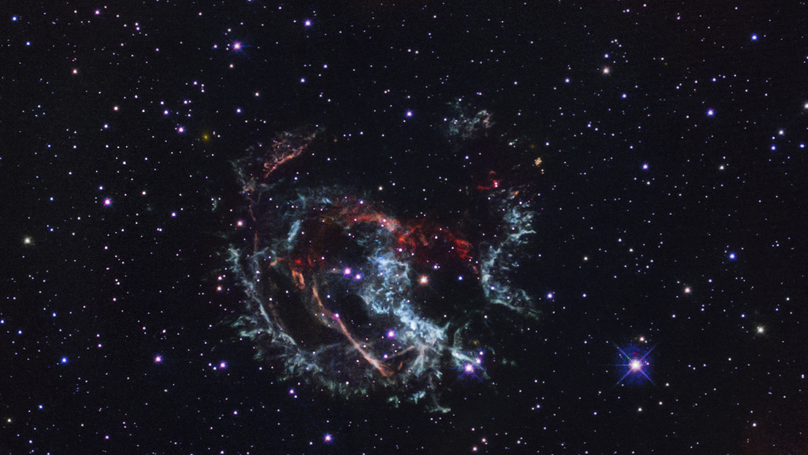John Banovetz
Graduate Student
Purdue University
Biography
I am a graduate student at Purdue University working with Professor Milisavljevic and the Time Domain Astronomy Group. I specialize in supernova remnants, especially using proper motion measurements to determine the age and explosion center of the remnant. In addition, I create 3D reconstructions of supernova remnants for morphological comparisons.
I also study diffuse interstellar bands. I use multi epoch observations to gain insights into the origins of the diffuse interstellar band carriers.
Download my CV.
- Supernova Remnants
- 3D Reconstuction
- Feature Identification
- Feature Tracking
- Diffuse Interstellar Bands
PhD Candidate
Purdue University
BS in Physics, 2016
Purdue University
BA in Chemistry, 2016
Hamline University
Research Interests
Supernova Remnants: Center of Expansion and Age
One of my research interests is determining the center of expansion and age of supernova remnants. These two properties are very important for remnant modeling, 3D supernova simulations, and companion star searches. One of the most robust methods to do this is measuring proper motions of supernova ejecta and use their trajectory and velocity to calculate the center of expansion and age.
Using this method, I helped determine the center of expansion and age for supernova remnant 1E 0102.2-7219. By measuring the proper motions of 120 knots of gas, our group was able to calculate a new center of expansion and age estimate for the remnant.
I plan of continuing this research for other supernova remnants. I also plan on creating an automated procedure for measuring the proper motions of the knots of gas.
3D Supernova Remnant Reconstructions
3D reconstructions of supernova remnants provide unique insights into the parent explosion and the subsequent remnant formation. This is especially important, as one of the major questions in astronomy is how much of the remnant morphology is created by the supernova explosion versus the surrounding environment.
My research interest lies in creating 3D reconstructions by utilizing integral field unit (IFU) spectroscopy. IFU spectroscopy uniquely allows observers to map the various elements of the supernova remnant in plane-of-sky space and Doppler velocities. This allows for a 3D reconstruction of the remnant in many elements, which creates a full picture of the remnant. Observers can then compare remnants to determine similarities or differences in structure and gain insights into the parent supernova explosion
Diffuse Interstellar Bands
Diffuse interstellar bands (DIBs) are an enigma in astronomy over a century old. They represent over 500 absorption features with no known carriers. Originally thought to originate in interstellar medium, there have been recent reports that have shown that some DIBs vary with time, indicating a source much closer to stellar objects.
My interest lies in trying to find more examples of time varying DIBs by obtaining spectra of stars at multiple epochs. This study will include studying more DIBs for time-variability as well as increasing the number of stars, to determine the type, if any, that produce this feature. By studying time-varying DIBs, we can gain insights into the production of DIBs carriers, the location of the carriers, and possible DIB-DIB correlations.
Featured Publication

We present new proper-motion measurements of optically emitting oxygen-rich knots of supernova remnant 1E 0102.2-7219 (E0102), which are used to estimate the remnant’s center of expansion and age. Four epochs of high-resolution Hubble Space Telescope images spanning 19 yr were retrieved and analyzed. We found a robust center of expansion of α = 1h04m02.48 s and δ = -72°01'53"92 (J2000) with 1σ uncertainty of 1"77 using 45 knots from images obtained with the Advanced Camera for Surveys using the F475W filter in 2003 and 2013 having the highest signal-to-noise ratio. We also estimate an upper limit explosion age of 1738 ± 175 yr by selecting the knots with the highest proper motions and these knots are assumed to be the least decelerated. We find evidence of an asymmetry in the proper motions of the knots as a function of position angle. We conclude that these asymmetries were most likely caused by interaction between E0102’s original supernova blast wave and an inhomogeneous surrounding environment, as opposed to intrinsic explosion asymmetry. The observed nonhomologous expansion suggests that the use of a free expansion model inaccurately offsets the center of expansion and leads to an overestimated explosion age. We discuss our findings as they compare to previous age and center of expansion estimates of E0102, as well as their relevance to a recently identified candidate central compact object.
Publications
Public Talks
AAS Journal Author Series:
AAS 237 Press Conference: Evolving Stars & Nebulae I:
https://www.youtube.com/watch?v=BlF0LvgRF8M&ab_channel=AASPressOffice
TheTundra: Beyond Space:
- jbanovet@purdue.edu
- 765-496-6514
- 525 Northwestern Avenue, West Lafayette, IN 47907